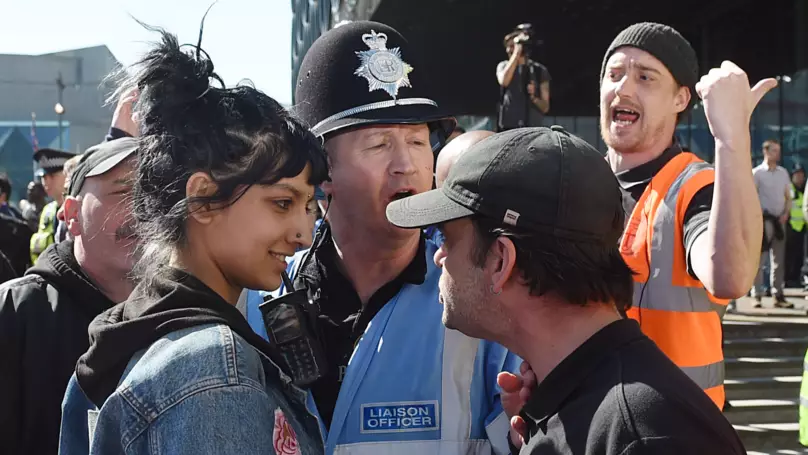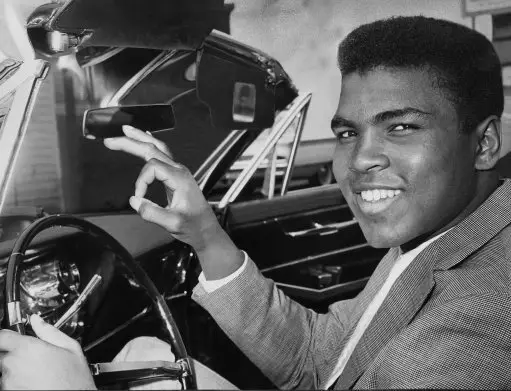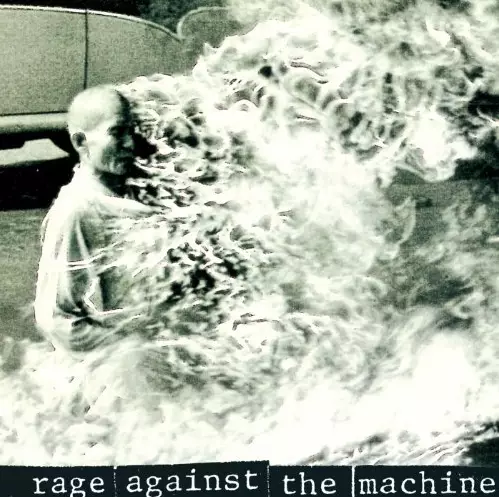
There are some people who just don't like the course that history has taken, and, ultimately, the direction in which the future is going.
With stronger nationalistic views creeping into society (Brexit, Trump, French elections), there are those who look at the bigger picture. Those whose ambitions are that of harmony and being united.
Only a couple of weeks ago, a picture went viral of Saffiyah Khan. The UK-born half-Pakistani, half-Bosnian stood and faced English Defence League (EDL) marcher.

Credit: PA
Advert
Khan said: "I didn't do anything, I was interested, that wasn't my intention.
"I knew they were trying to provoke me, but I wasn't going to be provoked. I didn't realise how many people would be so supportive, so it was worth it."
Every now and then history throws a remarkable figure that, in one moment, begins the wheels of change. LADbible looks at those defiant humans.
Tank Man
In 1989, China was undergoing rapid economic development and social changes. A movement of protesters demanded greater freedom of speech and government accountability.
Students took to Tiananmen Square, in Beijing, to protest but many hundreds were killed by troops. As tanks rolled in to the square, one man took a very bold leap.
Still unnamed, and his fate unknown, this LAD simply stood in the tanks' way, and the pictures ran across the globe.
Credit: BBC
The Chinese government's Communist Party of China (CPC) forbids discussion of the protests, but the economic impact was soon felt. Foreign loans to China were suspended, tourism decreased, and direct investment commitments were cancelled. Reform came, but it was much slower in implementation.
Rosa Parks
Not so much a stand, but a sit. Parks, the woman who fought for black civil rights, refused to give up her seat on a bus when a white man asked her to move (In 1950s America - black people would have to move either further to the back of the bus, or stand).
Her one-woman protest, soon merged into a large boycott (the Montgomery Bus Boycott) and she inspired further movements, headed by none other than Martin Luther King Jr.
A United States Court decision eventually declared the laws in place surrounding segregation were unconstitutional. The advancements soon after came thick and fast.
Muhammad Ali
Ali will always be known for his work in the ring. He was one of the greatest boxers of all time and was named Sportsman of the Century by Sports Illustrated.
But he was more than the man who spouted great quotes and threw magnificent punches. Ali was a man with strong self-belief, religious and political convictions.
In 1964, Ali failed the Armed Forces qualifying test because of poor writing and spelling skills. Two years later, changes to tests meant he was eligible, yet he still refused to fight in the Vietnam War.

Credit: PA
Advert
"War is against the teachings of the Holy Koran," he said. "We are not supposed to take part in no wars unless declared by Allah or The Messenger."
He also stood up against racism, refusing to answer to his birth name of Cassius Clay, saying that Clay was the name given to his family by a white slave owner. By refusing this, Ali was banned from fighting in the United States for the most of 1966 - only fighting abroad.
Mikail Gorbachev
Another political figure, Gorbachev, as President of the Soviet Union (now Russia), ripped up years of tradition in the country.
He went about dismantling the communist grip on power, helped to bring down the Berlin Wall, and sought an end to the Cold War.
He became the country's first democratically elected president in 1990, and went on to win the Nobel Peace Prize in the same year - championing social justice.
He was largely unpopular in Russia for his acts, but has been praised highly abroad. He was a critical of the supposed democratic election of Vladimir Putin for a third term in 2011.
But his work for countries such as Hungary and Czechoslovakia (modern day Czech Republic and Slovakia) broke the mould and years of a ruling Soviet Union.
Thich Quang Duc
His acts are probably the most extreme in this article. In a protest of the persecution of Buddhists by the South Vietnamese government, Duc burned himself alive in the middle of a road.
On June 11, 1963, Duc sat in at the intersection of a busy Saigon road, set crossed-legged whilst other monks poured petrol over his body and calmly set him alight.

Duc became the star of the cover of the Rage Against The Machine self-titled album. Credit: Rage Against The Machine
Advert
The monk, who had spent most of his life in service and teaching, heading and rebuilding temples, called out the government's oppressive policies and called for religious equality.
His actions, as severe as they were, prompted a quick regime change. JFK, US President at the time (with the States previously supporting the government regime), claimed: "No news picture in history has generated so much emotion around the world as that one."
All the above, plus numerous many more throughout history, go to show that an individual can make a big difference in changing the world. Whether in a position of authority, like Gorbachev and Duc, or a normal citizen, like Khan or Parks. Pictures taken in the right place, at the right time, can shock the world and prompt a reaction.
Featured Image Credit: BBCTopics: History, muhammad ali